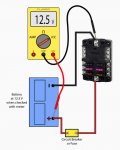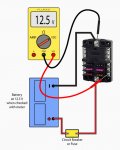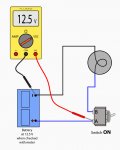Don S
Honorary Moderator Emeritus
- Joined
- Aug 31, 2004
- Messages
- 62,321
This is just a basic tutorial on how to use a Digital Multi Meter (DMM) to test voltage and ground to the boats fuse panel at the helm, and a little bit of other information at the end. It's not a end all tutorial, just a quick how to so you can get back on the water as soon as possible. You will probably find a need to get a book on marine electrical to really start understanding it, but with luck, this will get you back on the water until then.
Typically, you have a Positive and negative wire running from the battery to the helm fuse panel. In the diagrams following the panel has a negative buss bar built in at the top, and the lower section is for the positive 12V distribution.
There should also be a fuse or circuit breaker near the battery to protect the wiring going to the helm.
The first thing you must check is your battery voltage. Start by turning your DMM to Volts DC. Your meter will be different than the one shown, so look at the instructions that came with your particular meter.
The black test lead always goes in the Common terminal of the DMM, and the Red lead will go in the V/Ω terminal of the meter.
Touch the test leads to the battery terminals, not the cable, cable ends or the attaching nut. This will give you’re your battery voltage reading that you will compare all your other tests from. In the examples, I am using 12.5 v. Then touch the cable ends, the cable itself if open, and the attaching battery connectors to make sure you still have the same voltage.

Typically, you have a Positive and negative wire running from the battery to the helm fuse panel. In the diagrams following the panel has a negative buss bar built in at the top, and the lower section is for the positive 12V distribution.
There should also be a fuse or circuit breaker near the battery to protect the wiring going to the helm.
The first thing you must check is your battery voltage. Start by turning your DMM to Volts DC. Your meter will be different than the one shown, so look at the instructions that came with your particular meter.
The black test lead always goes in the Common terminal of the DMM, and the Red lead will go in the V/Ω terminal of the meter.
Touch the test leads to the battery terminals, not the cable, cable ends or the attaching nut. This will give you’re your battery voltage reading that you will compare all your other tests from. In the examples, I am using 12.5 v. Then touch the cable ends, the cable itself if open, and the attaching battery connectors to make sure you still have the same voltage.





























